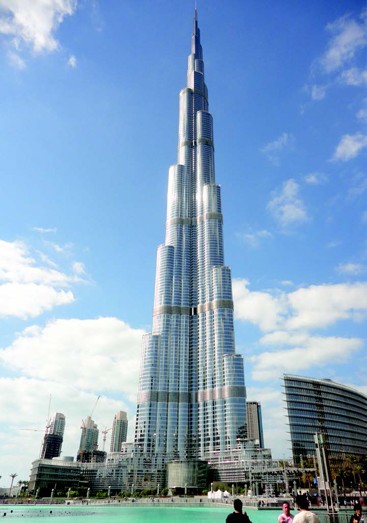Keeping Skyscrapers Steady

By Merry Morris
If you’ve ever been perched high in a tree when a stiff breeze blows, you know how unsettling a slight sway from vertical feels. Imagine being in a skyscraper with 50 mile per hour winds, buffeting your glass-enclosed condo or office. Feeling queasy?
Unsettling Real Estate
In the “old” days (think pyramids) building supplies were heavy, and the height of a structure was limited by the size and strength of its base. Things began to change in the 19th century when the problem of getting people up into very tall structures was solved by people-safe elevators. Elevators, which had been used only for materials, changed when Elisha Graves Otis developed the safety brake in 1853 which prevented a broken hoist cable from sending passengers down the elevator shaft.
Later that century following the destructive Chicago fire of 1871, the windy city began to grow rapidly. As available land for new buildings became scarce, there was incentive to build taller buildings.
Building upwards required new building techniques. Iron, and later steel, beams and columns provided a lighter, stronger skeleton that could withstand the forces of nature. These new buildings had to be sturdy and resistant to the forces of nature: snow, frost, wind, rain, baking sun, even earthquakes. The result was well-constructed buildings that withstood high winds. But just because a skyscraper won’t topple over, doesn’t mean it won’t move slightly. Tall buildings sway a bit in the wind, and tall, thin buildings sway more. That resulting sensation that the earth is unsteady beneath your feet can be quite unsettling. Though 50 mile per hour winds move a 1,000 foot high building just six inches, the movement is perceptible and the feeling makes most people woozy and anxious.
To make tall buildings less “exhilarating,” the central elevator core is strengthened and stiffened, and beams and columns are moved to the outside edges of the buildings. As greater heights are achieved (1,000 meter high buildings are now under construction), the need for additional support came from an unexpected source: immense dampening systems.
These giant counterweights built into the top of the building, can weigh up to 300 to 800 ton — imagine 100 African elephants or 23 Sherman tanks! A tuned mass damper may require to 1,000 square feet and hangs attached to the skyscraper’s walls with numerous pistons and spring mounts, like a giant pendulum. A slosh damper substitutes tons of water for solid mass. When high winds buffet the building, the damper acts like a shock absorber. In modern systems, when a computer detects building sway in one direction, the damper is set to counterbalance the motion. Less motion means less acceleration.
Extension Questions
- Using a classroom building set, construct “buildings” of various designs. Which are most stable?
- Review the Chicago fire of 1871. What were the causes and results?